Slow-roasted pork shoulder with potatoes on the sides. A delicious flavor mix of orange, balsamic, mustard, and herbs. This juicy and tender pork shoulder roast is the best holiday dinner!
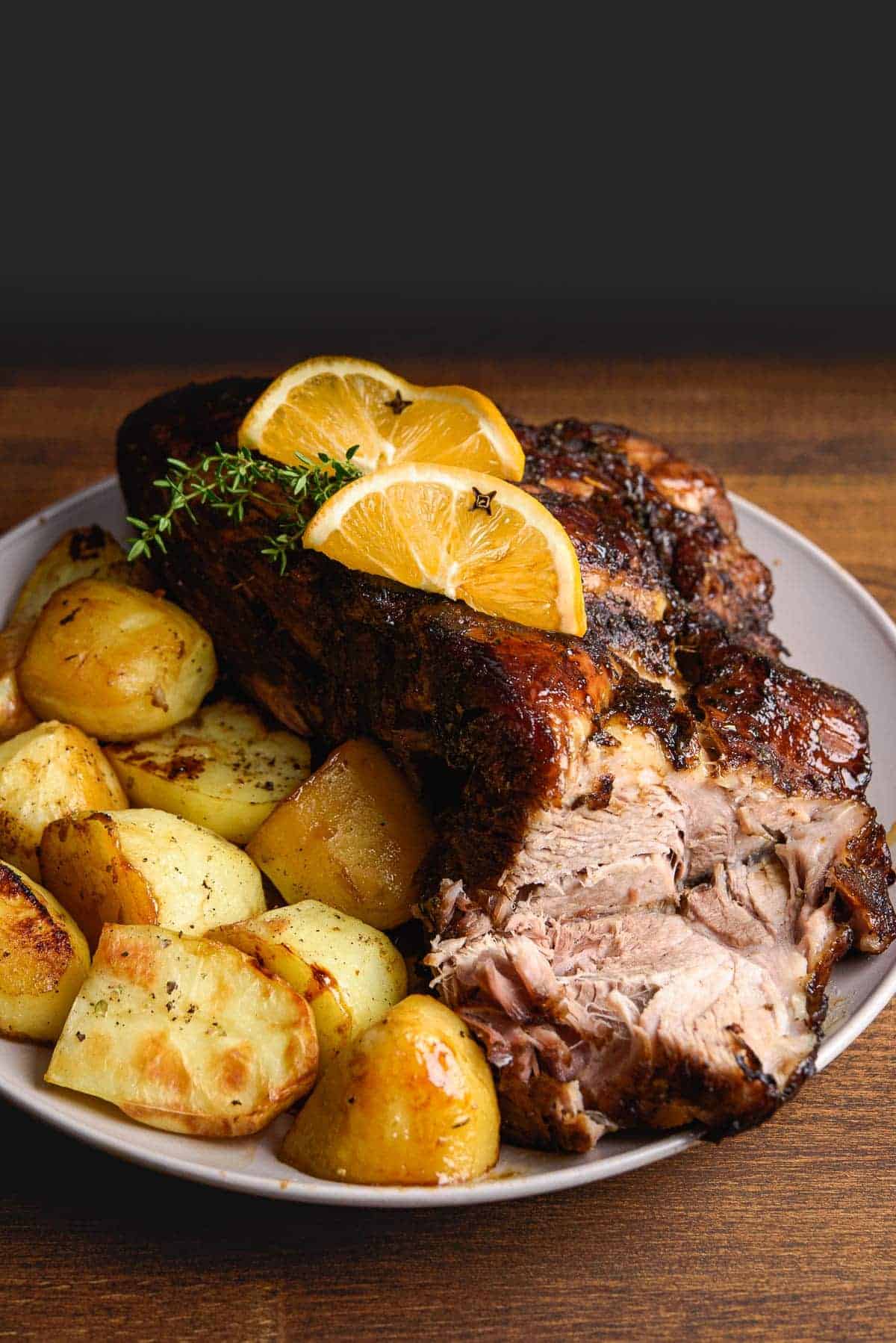
And I still haven't told you what makes it the best. It's the brine! Yes, this oven-roasted pork shoulder gets brined overnight. So you get a piece of meat tenderized and seasoned to its core.
This makes all the difference since pork is a meat that usually dries up when you bake it. And brine locks moisture into the meat keeping it soft.
Table Of Contents
Greek Christmas Pork
In Greece, we serve this pork shoulder roast recipe mostly on Christmas or around the holidays. In fact, that's what was traditionally served throughout the years on Christmas day, until the Christmas turkey tradition came along.
Though still, most people in Greece, serve pork on Christmas. Together with other traditional Greek Christmas dishes like pies, breads, and Avgolemono.
Brining Pork Shoulder
Brined pork shoulder is much more flavorful and tender than non-brined. The brine helps to season the meat all the way to its core (while a marinade seasons mostly the surface). Brining pork shoulder is almost essential especially when it's a large piece of meat and the seasonings can't reach the center.
The brine for pork shoulder is made of water, white wine, kosher salt, and seasonings like peppercorns, cloves, bay leaves, allspice berries, cinnamon, and thyme.
This pork shoulder brine is a simple one, with warm spice flavors. If you wish you can toss in 2-3 garlic cloves as well. Or swap the white wine for red if you want a stronger flavor.
TIP: You can toast the seasonings for the brine in a frying pan before adding them to the brine. This will enhance their aromas.
You can brine the pork in the fridge overnight or for up to 2 days before cooking.
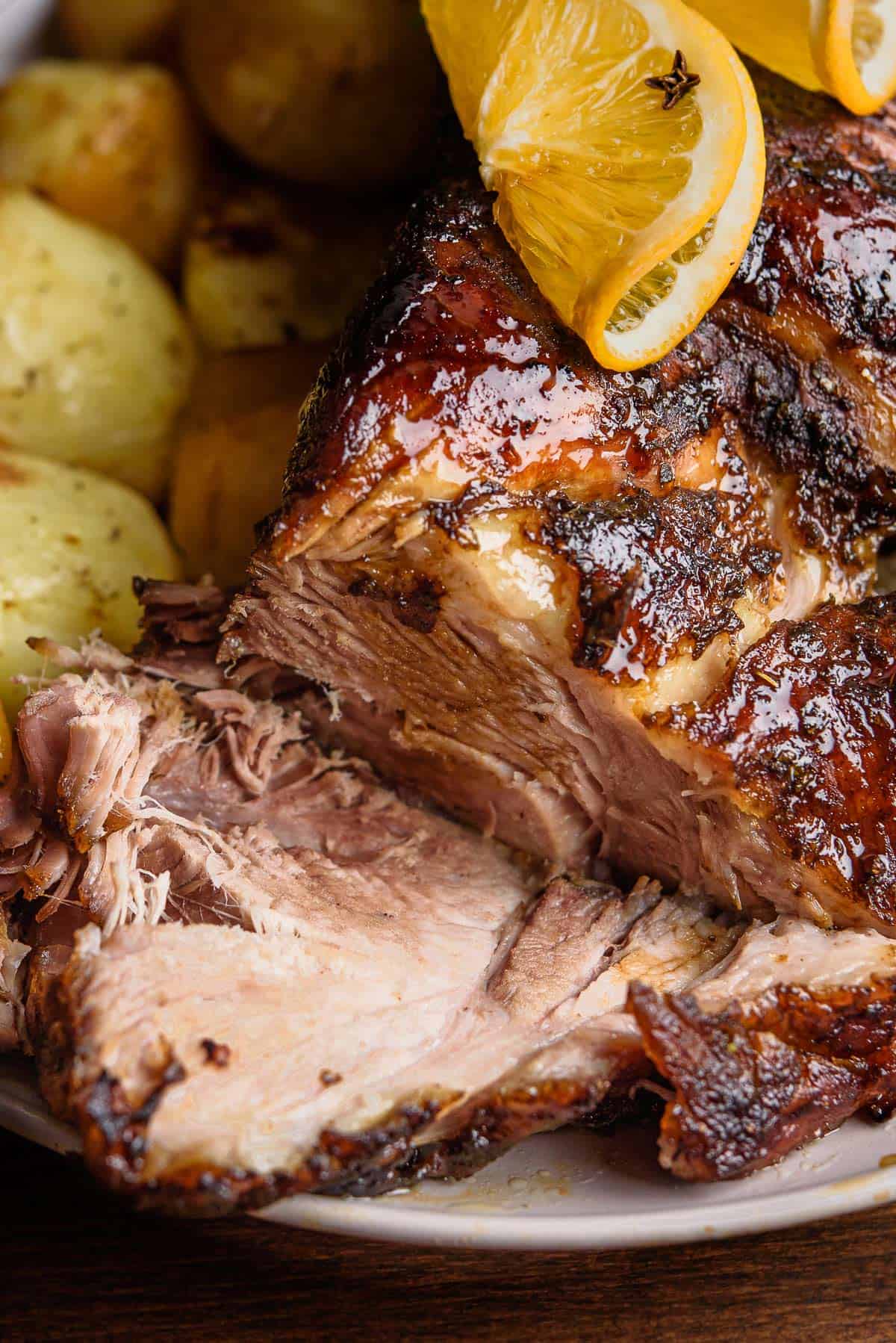
Slow Cooking
Slowly cooking pork shoulder in oven covered, is the best way to cook pork shoulder. Because it ensures the meat gets tender on the inside before roasting its outer skin. Plus, when you cover the meat all the flavors you add to the pan are trapped inside. And by slow-cooking they have the time to penetrate into the meat.
To slow-cook pork shoulder in oven use either a roasting pan with a lid or use a plain pan with a DIY cover. To cover the pan if it doesn't have a lid simply use some parchment paper and aluminum foil on top.
Then allow it to cook slowly at a low temperature for a couple of hours before uncovering the meat and roasting it.
How Long To Cook Pork Shoulder In Oven
Cooking time depends on the weight of the meat. For this recipe, we use a 4.4-pound (2 kg) piece of meat and bake it for 2 hours + 25 minutes of roasting.
If you are planning on using a bigger piece of meat you will need to adjust the cooking time.
For every extra kilogram (1 kilogram =2.2 pounds) of meat add about 30 minutes extra baking time. Uncovered roasting time remains the same.

How To Roast Pork Shoulder
After slow-cooking pork shoulder in oven, it's time to roast it! To give it a nice brown color on top. For this to happen we need to uncover the meat (obviously), and raise the oven temperature.
In this recipe, we also baste the meat with a mixture of orange juice, honey, and balsamic vinegar to add extra flavor and color.
So the process goes like this: roast for 10 minutes. Baste, roast for 6 minutes, baste, and roast for 6 minutes more. At this point, the pork should look nicely browned. But if it isn't as much as you like you can roast it for a few minutes more.
NOTE: Due to the cooking method and basting, this oven-slow-roasted pork doesn't get crispy on top.
Pork Shoulder Or Pork Butt?
Both cuts come from the same primal cut on the shoulders. So they can be used interchangeably in pork shoulder butt recipes. They have very minor differences mostly regarding the fat content and distribution.
For example, pork shoulder is more lean and the fat is mostly on the surface while pork butt contains fat within its muscles. This means that pork shoulder is ideal for roasts (especially if you want crispy skin on top).
While pork butt is more tender. Therefore, roast pork butt in the oven is equally good and may turn out even more moister than roast pork shoulder.
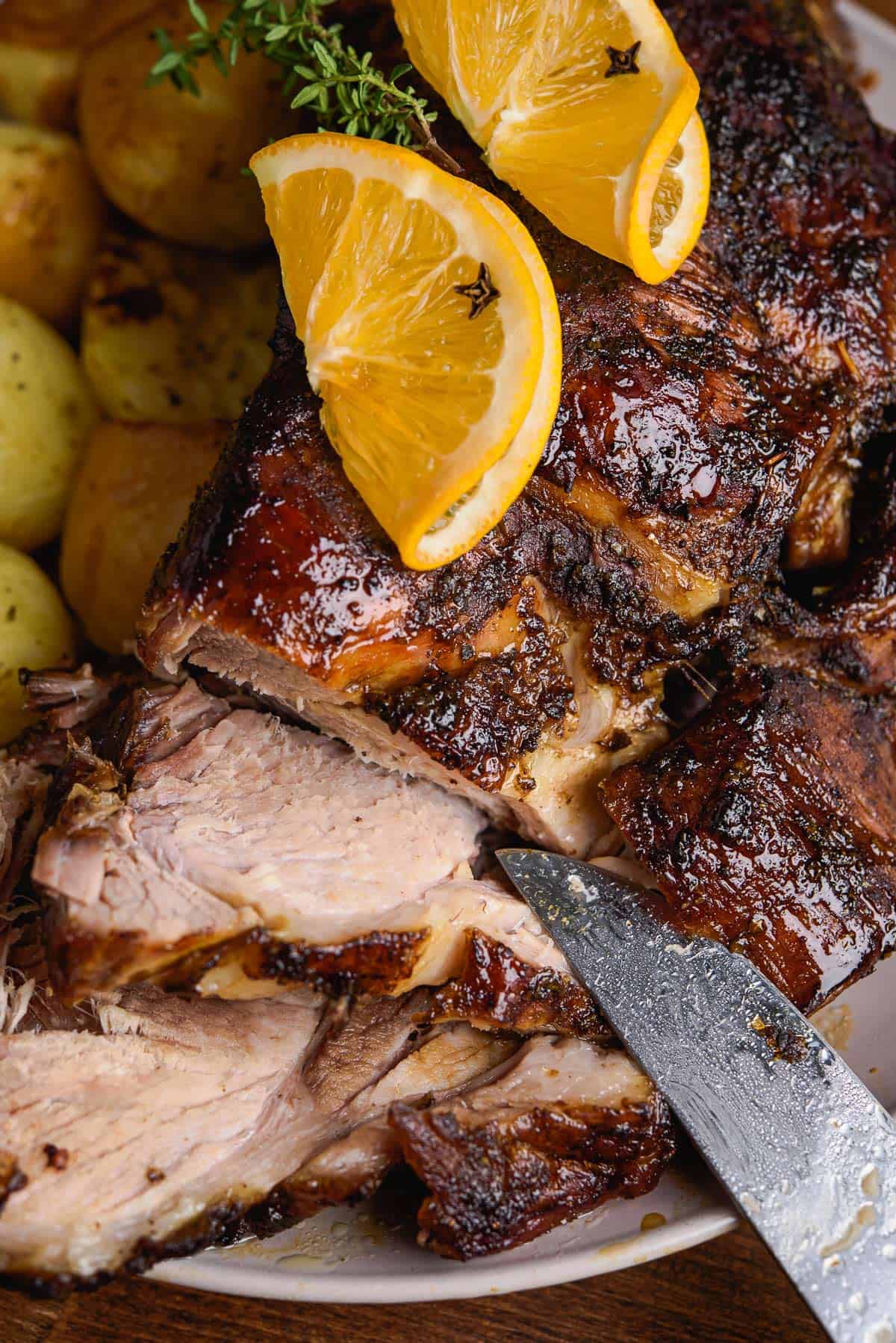
Can I Use Bone-In Pork Shoulder?
You sure can! It will result in even more tender and juicy meat. Though more difficult to cut and serve. Also, make sure you adjust the weight. For instance, this recipe calls for 2 Kg (4.4 pounds) of boneless pork shoulder. If you want to use bone-in pork shoulder go for a 3 kg piece of meat for the same amount of portions.
Adding Potatoes Or Veggies
You can add potatoes and cook them together with the pork. To do this you need to boil them first for a few minutes until they get a bit soft. Then add them to the pan with the pork right when it's time to uncover the pork and roast it.
To give extra flavor to the potatoes use some of the pork fat (as instructed in the recipe below).
If you don't want to add potatoes you can toss some veggies and roast together with pork. Broccoli, cauliflower, carrots, pumpkin or squash, and even yams all pair nicely with roasted pork. Just cut them into florets or cubes, mix them with some seasonings (such as oregano, thyme, marjoram, garlic powder, onion powder), and roast them!
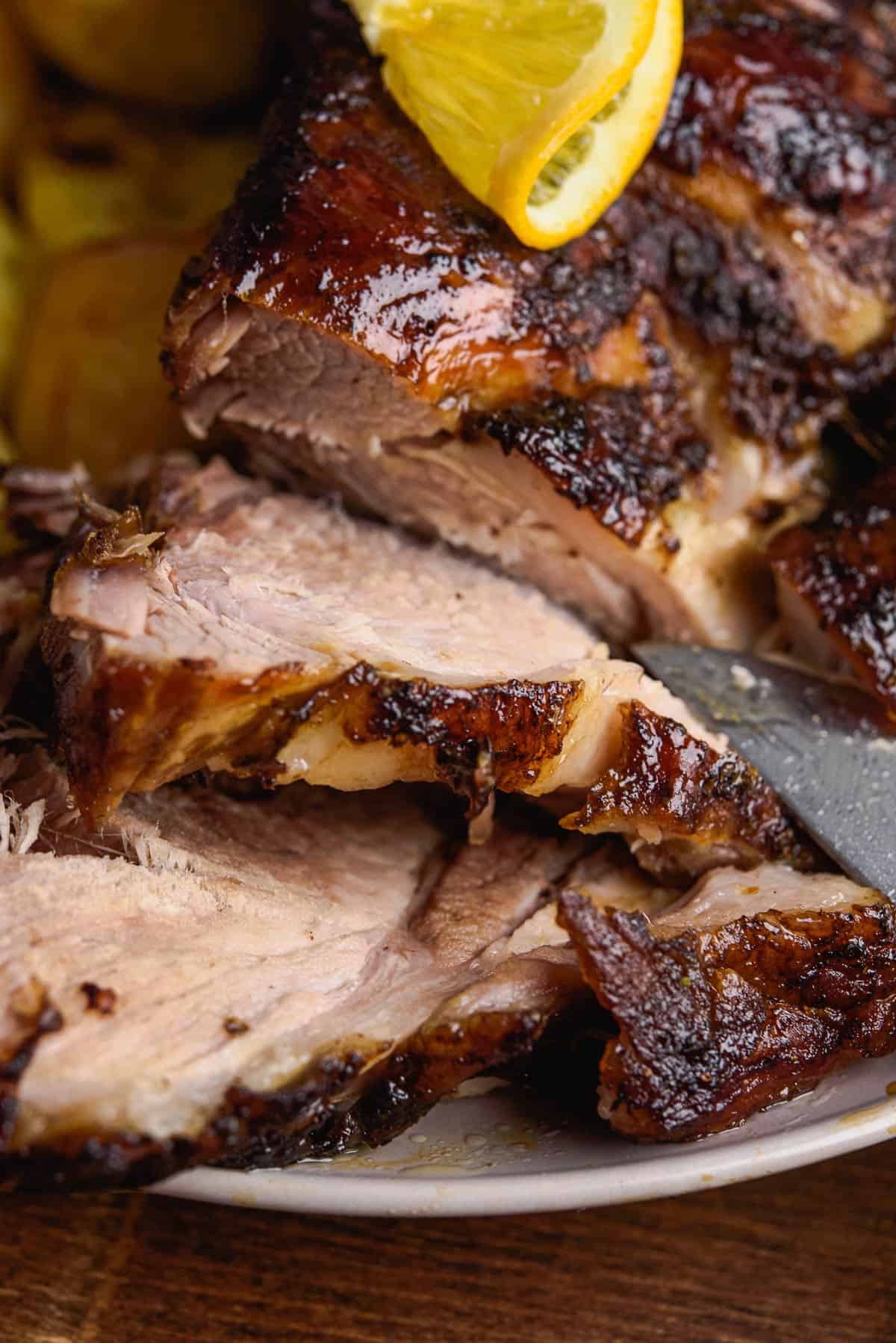
SERVE WITH 🠳
This roast pork shoulder is great to serve with a red wine reduction sauce. Especially if you are serving it on a special occasion this sauce will make this roast even more special.
Side dishes to serve with roasted pork shoulder:
If you won't be cooking the potatoes together with the pork you can make any of the following potatoes as a side to this dish.
Salads that are great to serve with:
Recipe
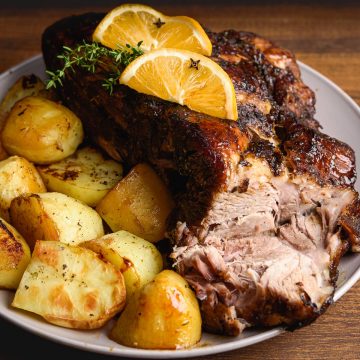
Roasted Pork Shoulder (brined + orange flavored)
Equipment
- 1 x Roasting Pan
Ingredients
- 2 kg / 4.4 pound Pork Shoulder Boneless
- 3-4 sprigs of thyme
- 3-4 sprigs of sage
- 100 ml red wine
- 1 orange juiced don't discard the cups
- 2 tablespoons Balsamic vinegar
- 1 tablespoon honey
- 55 ml fresh orange juice
For The Brine:
- 4 cups (1 liter) lukewarm water
- 1 ½ cups (750 ml) white wine
- 4 tablespoons kosher salt
- 6 allspice berries
- 6 cloves
- 5 bay leaves
- 6-7 peppercorns
- 1 stick of cinnamon
- 2-3 sprigs of thyme
For The Rub:
- 20 grams / 0.7 oz Grape molasses (or molasses)
- 1 teaspoon Balsamic vinegar
- ½ teaspoon ground allspice
- ½ teaspoon garlic powder
- 1 teaspoon mustard powder
- 1 teaspoon dried marjoram or thyme instead
For The Potatoes (optional):
- 800 grams / 28 oz potatoes peeled and cut into 5 cm pieces (2-inch)
- 1 teaspoon dried marjoram
Instructions
Brine The Pork (the night before):
- Trim most of the fat from the surface of the pork leaving only a little.
- Add pork to a large bowl (glass or plastic) that fits it. It shouldn't be much wider than the meat because we want it to sink in the brine.
- Add all of the seasonings as well except the salt.
- Dissolve the salt in 1 liter of lukewarm water and add to the bowl. Pour the wine in as well.
- Refrigerate overnight or you can leave in the brine for up to 2 days.
Cook The Pork:
- Remove the pork from the brine. Pat it dry with paper towels.
- Preheat oven to 160°C / 320°F.
- Place the pork in a roasting pan if it has a rack place it on the rack. If using a plain pan that's okay too.
- Combine all of the ingredients for the rub in a small bowl. Then rub it all over the top surface and sides of the meat.
- Add the sprigs of thyme, sage, and orange cups to the pan.
- Pour the red wine and orange juice into the pan.
- Cover by putting the lid on (if using a roasting pan with a lid), or cover with a big piece of parchment paper and then secure it with a piece or two of aluminum foil on top. Make sure it's closed well on the sides.
- Bake for 2 hours.
- Prepare The Potatoes: meanwhile, if you wish to add potatoes as well, boil them in some salted water for 10 minutes. Then remove them with a slotted spoon and set them aside in a bowl.
- Remove the pan from the oven without uncovering it.
- Raise the oven's temperature to 220°C / 428°F. Wait for 10 minutes.
- Uncover the pork. Carefully drain most of the liquid from the pan into a bowl. Leaving only a very thin layer just enough to cover the surface of the pan. NOTE: Do not discard the parchment paper and aluminum foil cover.
- Add the potatoes all around the pork. If using a roasting pan with a rack place the potatoes underneath the rack.
- Skim off some fat that has risen on the surface of the pork liquid you just drained.
- Drizzle the fat over the potatoes. About 6-7 tablespoons of it.
- Season the potatoes very lightly with table salt, pepper, and 1 teaspoon of dried marjoram.
- Add back in the oven and roast for 10 minutes.
- Meanwhile, in a small bowl mix together the 2 tablespoons of Balsamic vinegar, 1 tablespoon of honey, and 55 ml of fresh orange juice.
- Remove the pan from the oven.
- Drizzle ½ of the mixture all over the pork.
- Place the pan back in the oven.
- Roast for 6 minutes more.
- Remove the pan from the oven once more and drizzle the meat with the remaining ½ of the mixture.
- Roast for 6 minutes more. Then remove the pan from the oven.
- Carefully transfer the pork shoulder to a serving plate using two large spatulas. Or use the parchment paper and aluminum foil cover to gently grab hold of it and transfer it. And then use it to cover the meat again. Note: If you didn't add the potatoes there's no need to transfer the meat. Simply cover the meat inside the pan.
- Rest the meat for 30 minutes.
- Drop the oven's temperature to 200°C / 392°F.
- Place the pan with the potatoes back in the oven and roast the potatoes until nice and crispy on the edges. If you wish, toss and squeeze them with a spatula to make them even crisper.
- Cut thin slices of the pork and serve along with the potatoes and enjoy!
- This red wine sauce goes great with this dish making it even more festive!

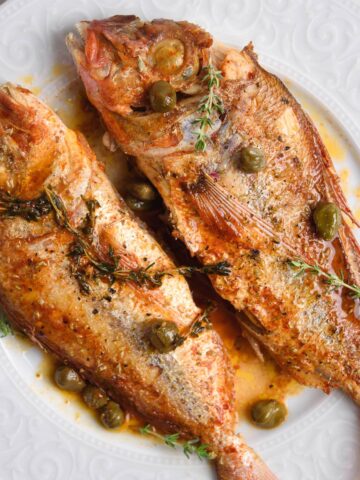
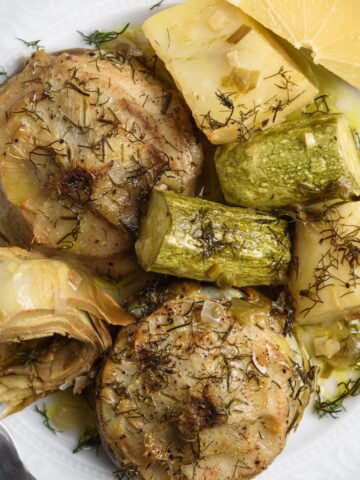


Hi. I'm making this today, but can you tell me what you mean by this..
1 orange juiced "don't discard the cups"??
Hi David, the cups are added to the pan as stated in the recipe.